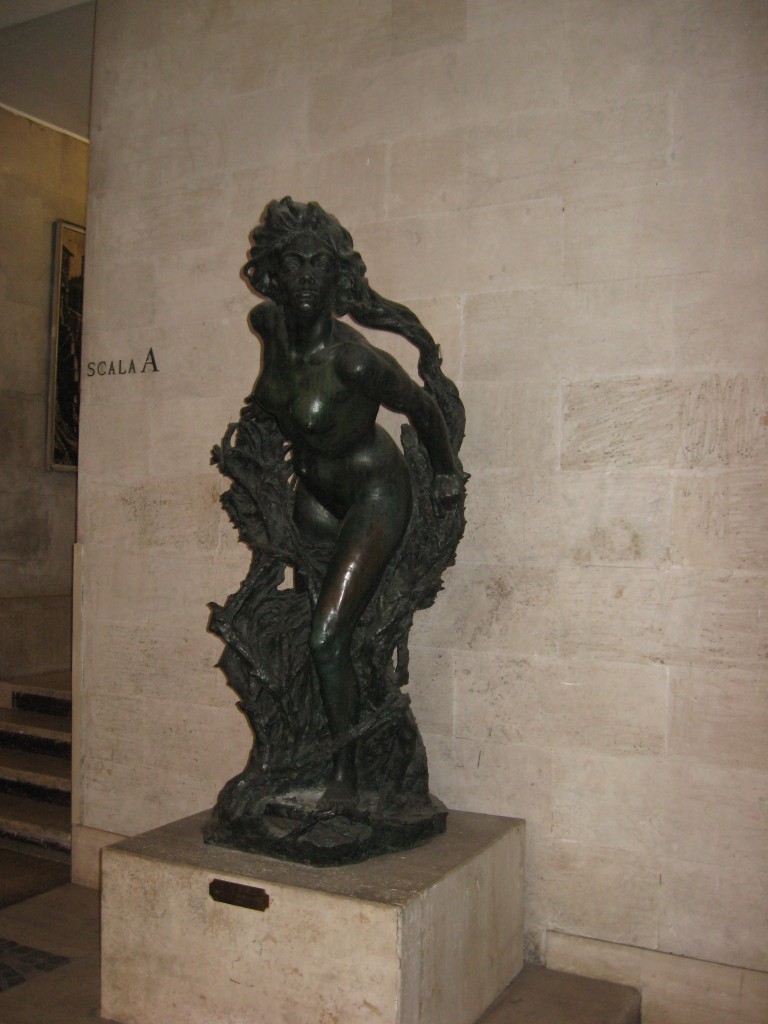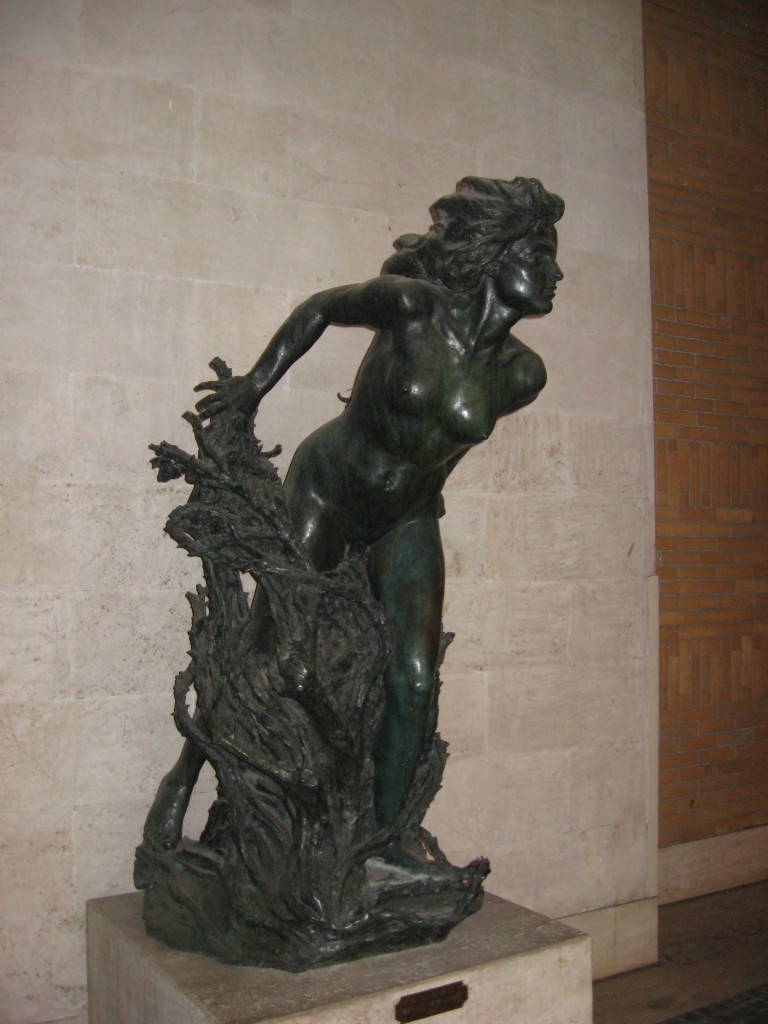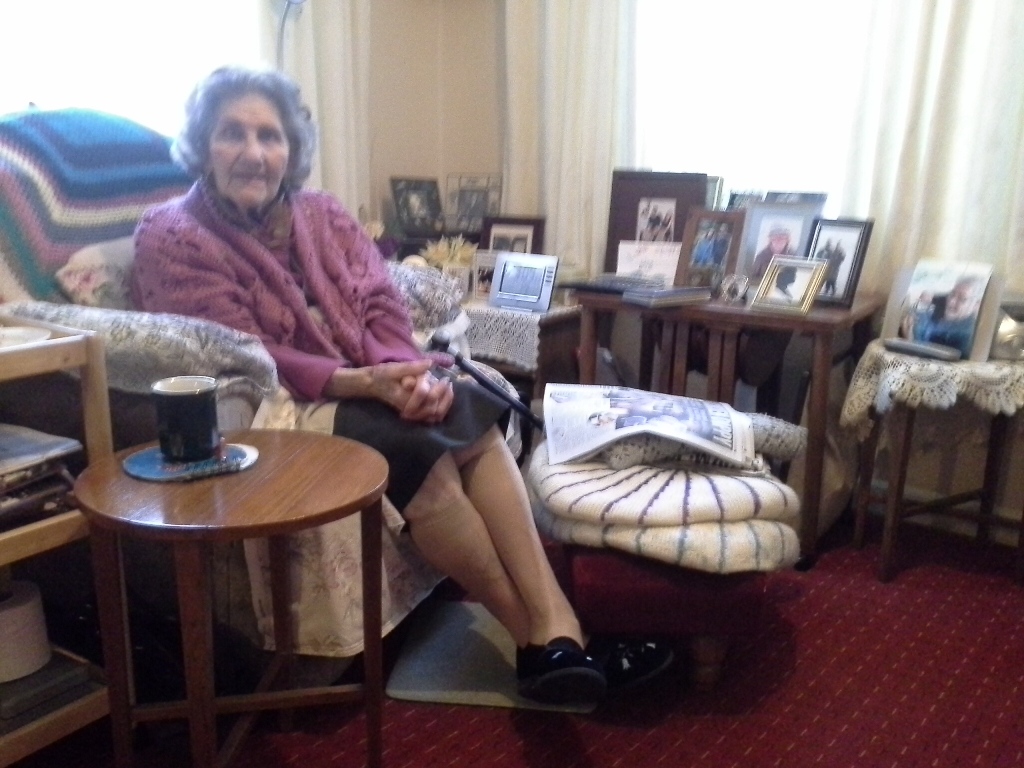by The Curious Scribbler
There have been several developments in the story of ‘Humanity emerging from the Horrors of War’, the somewhat unexpected sculpture at the foot of Aberystwyth’s war memorial. ( search ‘Rutelli’ in earlier blogs to follow the story). Through internet searches I had located an apparently identical sculpture, in Rome, which, according to Marco Demmelbauer, the restorer who had worked on her some twenty years ago, was called Verità esce dai rovi ( Truth emerges from the bushes).
Recently I had a message from Rome-based historian Nicholas Stanley Price who went in search of her at Via delle Quattro Fontane 18. He reported instead that she is now to be found at Via delle Quattro Fontane 15, next door to the Palazzo Barberini, home of the National Gallery of Art. She is indoors now, in a hallway, and the context of the pictures reveal that rather than being a precise duplicate, Truth is half the size of Aberystwyth’s lusty Humanity. Moreover there are some discernible differences, especially in the twiggy foliage from which the figure emerges.

Truth emerging from the Bushes, in the hallway of Via Quattro Fontane 15, Rome Photo Nicholas Stanley Price
Now I have another correspondent, Alan Wynne Davies, who is off to Rome shortly to have a look at her. I hope he may be able to throw light on that sculpture’s history. I believe she was taken for restoration from an outdoor situation in the courtyard of a block of flats at No 15. It would be nice to find out when she was actually commissioned, and whether the design follows or pre-dates the Aberystwyth nude which records show was being cast in Rome in April 1922 and shipped by Thomas Cook to Liverpool in October 1922.
And in a separate strand, I was given the chance to follow up on a recurrent urban legend: that the Aberystwyth sculpture was modelled upon the wife of the proprietor of Ernie’s Fish bar in this town! The trail led to Nora James of Trefechan, a handsome elderly lady who is a local matriarch and daughter of the alleged model. Mrs James’ mother Maria Pelizza was married in Italy to Ernest Carpanini, an Italian who had worked in the restaurant and ice cream business in South Wales before the first world war. Moving first to Llanelli, the young bride found herself by 1922 in Aberystwyth where her husband Ernest and his partner Joe Chiappa opened a chipshop called ‘Ernie’s’ by the town clock. Maria spoke very little English and mainly worked in the kitchen, but both she, and the massive sculpture on the memorial were new to town, beautiful and Italian. Thus, I believe, the myth was born, perhaps as a tease by the customers.
Nora recollects that her mother always dismissed the allegation, and no member of the family supported the outrageous suggestion that she had ever modelled in the nude. However the the myth was accommodated with the vague suggestion that someone “had got hold of a photo of her face” and that this likeness was reproduced. More prosaically I think that the likeness was a coincidence born of the Italian features of Maria Pelizza and the Italian model in Rome.
Ernesto and Maria Carpanini founded an extensive Welsh family and most of their grandchildren work in or around Aberystwyth. It is a sad note that Nora recollects that her father, who was on account of his nationality interned on the Isle of Man for the entire second world war, returned home a shadow of his former self in 1945 and never fully regained his former spirits.



Hello again, I was in contact with you a few months ago.
Well, I made it to Rome last week. I was there on business and I went in search of the original sculpture of the fine looking woman on the War Memorial at Aberystwyth. The details in your blog are correct, she is now in a private courtyard, in the Via Delle Quattro Fontane, next to the National Museum of Ancient Art and opposite the Hotel Quattro Fontane, guarding a small car park. The courtyard is called the Condominio Via XX Settembre, 1 Via Quattro Fontane.
There is a plaque on the plinth, which reads;
MARIO RUTELLI
LA VERITA ESCE DAI ROVI
1909
My Italian dictionary translates ROVI as BRAMBLES, but emerging from brambles might be uncomfortable for her, so perhaps bushes is better. Unless that is how she lost her clothes!
She is about life size (the figure is around five feet tall) and obviously well preserved as she has recently been restored (but I have no details on that) and now under cover.
I also visited the massive monument to Victor Emmanuel, the first king of the united Italy. (That’s where 20 September comes in, celebrating the unification of Italy and the freeing of Rome from Papal control in 1870). There are two versions of Rutelli’s winged Victory on the Roman monument, which is also on the War Memorial at Aber.
One has her standing on her left foot and not holding a laurel wreath in her right hand, but waving.
In the other, she is standing on her right foot, holding a laurel wreath in her left hand.
Whereas of course in Aber, she is standing on a globe of the world, standing on her right foot, holding a laurel wreath in her right hand.
I can’t work out how to attach photos to this letter, but I have put some photos on Panoramio
See http://www.panoramio.com/photo/108735746 for the Aber Humanity
See http://www.panoramio.com/photo/114024116 and http://www.panoramio.com/photo/114024124 for the original Roman version
See http://www.panoramio.com/photo/108735742 for the Aber Victory
See http://www.panoramio.com/photo/114042395 and http://www.panoramio.com/photo/114042403 for the Roman Victories
Another visit took me to Piazza Republica, where there is huge fountain with four nymphs surrounding a central figure. All by Rutelli and all naked. (There is a theme emerging here!). This was controversial when it was constructed but is now regarded as the finest of modern fountains in Rome.
Best wishes and keep up the good work on news from Aber.
Regards
Alan Wynne Davies
Thanks for this, you’ve obviously had a very productive visit.
Regarding the Winged Victories at the Monument to Victor Emmanuel II, there seem to be a considerable number of them! My blog of 21 January 2013 shows two winged victories there, photographed by Marco Demmelbauer, the restorer of ‘Verita’. They are both standing on the top of freestanding pillars, and poised upon bronze spheres. One, on the left foot seems to be exactly like the Aberystwyth one by Rutelli, ( except a mirror image), while the other on the right foot, carries a sword, and is by Arnoldo Zocchi. Your two photographs show figures standing upon ornate brackets extending from the stonework, and neither stands on a sphere! So I take it there are at least four slightly varying figures and at least two sculptors who may be responsible. I think my vote would go for the first of your two pictures, No 108735742 being by Zocchi, since it seems a bit more staid and less dynamic (and carries a sword).
Do you think your waving Victory might have dropped her wreath?
I also wrote about the Naiads in the Piazza della Republica on 16 January 2013. I have become rather an admirer of Rutelli!
According to my mother -in-law, Beatrice Mary Mutgatroyd, born 1909 in Halifax, Yorkshire the face at least is of Gertrude Hoyle who was a relative by marriage of her mother, Hilda Beatrice Hoyle also of Halifax. The story I was told is that Gertrude was on honeymoon in Aberystwyth but on the first day her new husband developed a stomach upset and was unwell all week. The sculptor was staying in the same hotel and was so taken by Gertrude’s face that he asked her to model for him.
I am sure this can be checked by contacting any remaining family on Halifax.
My mother -in-law’s married name was Woodroffe
She died on Cornwall in 2008 and is survived by one son.
Well it seems that Maria Carpanini, Beatrice Murgatroyd, and an unnamed Belgian lady all have similar claims to this story! I suppose it is possible that the charming Mario Rutelli used this as a chat-up line to many a beautiful young woman. However it is also notable that the woman in the sculpture also strongly resembles the nudes in the Fountain of the Naiads in Rome, who in turn in the Italian Guide books have been identified as modelled upon celebrated twin Roman courtesans of the day!
The first appearance of the model Truth / Humanity coming out of the bushes was a garden sculpture which stands in Rome, dated 1909. I suppose that the date of Gertrude’s honeymoon could throw light on the chronology of these events?
I have published a much fuller account in Ceredigion Vol XVII, no 4, 2016
Whatever the source — and if you look at all closely you’ll see that Veritas has a very different face — Humanity is a graceful and beautiful work of, and you should be ashamed of your post that labeled it “raunchy.” Does not all humanity emerge from the violence of birth naked? Is not war a violent force that strips away the covering of civilization? And are not many scultures of the nude human body great works of art? In the decade since that post, have you matured sufficiently to regret the use of the word “raunchy”?
No, I haven’t!